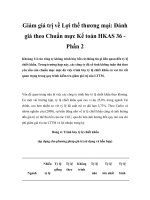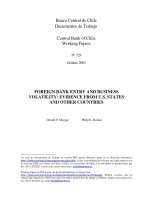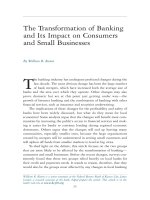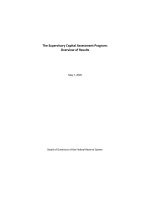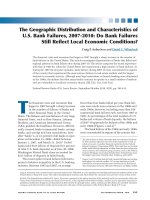The I Can Save Program: School-Based Children’s Saving Accounts for College docx
Bạn đang xem bản rút gọn của tài liệu. Xem và tải ngay bản đầy đủ của tài liệu tại đây (328.31 KB, 36 trang )
CSD Working Paper
The I Can Save Program:
School-Based Children’s Saving
Accounts for College
Margaret Sherraden, Lissa Johnson, William Elliott,
Shirley Porterfield, and William Rainford
CSD Working Paper 06-02
2006
Center for Social Development
The I Can Save Program:
School-Based Children’s Saving Accounts for College
Margaret Sherraden
Professor, University of Missouri at St. Louis
Research Professor, Center for Social Development, Washington University
Lissa Johnson
Project Director, Center for Social Development, Washington University
William Elliott
Research Associate, Center for Social Development, Washington University
Shirley Porterfield
Associate Professor, University of Missouri at St. Louis
William Rainford
Assistant Professor, Boise State University
CSD Working Paper 06-02
2006
DRAFT: Comments Invited
Margaret Sherraden
School of Social Work, 507 Lucas Hall, One University Boulevard, St. Louis, MO 63121,
Submitted for review to Children and Youth Services Review
Center for Social Development
George Warren Brown School of Social Work
Washington University
One Brookings Drive
Campus Box 1196
St. Louis, MO 63130
tel 314-935-7433
fax 314-935-8661
e-mail:
HTTP://GWBWEB.WUSTL.EDU/CSD
Acknowledgements
The authors express their gratitude to the research funders: the Center for Social Development,
University of Missouri Research Board, and the National Council for Economic Education, and
the coalition of foundations that support the Saving for Education, Entrepreneurship, and
Downpayment (SEED) projects, including the Ford Foundation, Charles Steward Mott
Foundation, MetLife Foundation, Charles and Helen Schwab Foundation, Jim Casey Youth
Opportunity Initiative, Citigroup Foundation, Ewing Marion Kauffman Foundation, Richard and
Rhoda Goldman Fund, Evelyn and Walter Haas, Jr. Fund, and the Edwin Gould Foundation for
Children. Victoria Gonzalez-Rubio, the school principal, and Christopher Krehmeyer, Director
of Beyond Housing/NHS, helped create the program. They, along with the school’s dedicated
teachers and project staff, Linda Thomson, Sabrina Baldwin, and Inesia Robinson, as well as past
project coordinators, Amy Elliott and Lisa Reyes Mason, supported the research throughout.
This study would not have been possible without the enthusiastic participation of the children
and their parents in I Can Save.
School-Based Children’s Savings Accounts for College
Abstract
The I Can Save Program:
School-Based Children’s Saving Accounts for College
This paper examines an innovative college savings program for public elementary school
children. The project is based on the proposition that children will gain financial knowledge and
be more likely to view college as an attainable goal because they are accumulating savings to
help pay for higher education. As the latest in a long history of school-based savings programs,
this program pioneers the idea of matched savings in which children and family savings in the
students’ accounts are matched one to one up to a maximum of $3,500. Findings suggest that the
principal, teachers, children, and their families are enthusiastic about the program. Saving
patterns show that families can save, but low levels and patterns of saving suggest that structures
that compel regular saving and boost saving rates would improve saving rates and regularity. The
program successfully teaches financial education through an after-school club, but it has been
more difficult to incorporate it into the classroom. Universal children’s savings accounts may
circumvent some of the limitations of this program, although more research is required to assess
what program components are most effective.
Center for Social Development
Washington University in St. Louis
2
School-Based Children’s Savings Accounts for College
The I Can Save Program:
School-Based Children’s Saving Accounts for College
This is about creating, in a free enterprise system, access at an early age, for kids
to understand what the power of compound interest is, what the power of savings
is, what it will allow you to accomplish in your life, ultimately putting a down
payment on a higher education opportunity for every child… – Senator Jon
Corzine, July 22, 2004
These comments by then Senator Corzine at a press conference introduced a bipartisan proposal
for a children’s saving policy called the ASPIRE Act (America Saving for Personal Investment,
Retirement, and Education Act, 2004). The ASPIRE Act would create “KIDS Accounts,” or a
savings account for every newborn, with an initial $500 deposit, along with opportunities for
financial education1. Children living in households earning below the national median income
would be eligible for both a supplemental contribution of up to $500 at birth and a savings
incentive of $500 per year in matching funds for amounts saved in the account. Withdrawals
would be allowed when the account holder turns 18. Tax-free withdrawals could be made to pay
for post-secondary education, first-time home purchase, or retirement security.
With this proposal, children’s savings accounts (CSAs) have been placed on the U.S.
policy agenda, joining other countries, such as the United Kingdom, whose Children’s Trust
Fund is the model for the ASPIRE Act (Aspire Act, 2004). There are many options for how to
implement CSAs. The most comprehensive and universal approach would be to open a savings
account every time a child is born in the United States as proposed in the ASPIRE Act. Another
model is to open an account for all children when they enter preschool or primary school. This
1
At this writing, the ASPIRE Act remains on the Congressional agenda
( />
Center for Social Development
Washington University in St. Louis
3
School-Based Children’s Savings Accounts for College
paper begins with a review of the history of school-based savings, and follows with an
examination of a contemporary school-based savings program for elementary school children. It
presents evidence from the first two years of the program, on enrollment, reaction to the
program, initial savings patterns, and program design. Evidence from this demonstration informs
the larger policy discussion about CSAs.
Access to College
Research findings show that low income and low wealth children are less likely to
matriculate and graduate from college,2 despite high aspirations for education (ACSFA 2002)
and recognition that post secondary education is important (Immerwahr & Foleno 2000; SCSFA
2001). Among minority youth 18 to 19 years old, only 30 percent of Hispanic and 40 percent of
African-Americans, compared to 49 percent of whites, enroll in college (Census Bureau, 2004).
ACSFA finds that low-income college-qualified high school graduates are 29 percent less likely
to test for and apply to a four-year college than high-income college qualified high school
graduates (2002). These statistics translate into disparities that reduce the likelihood of later
economic success (Wilson, 1987), including lower income and earnings (King and Bannon,
2002), less stable employment (Topel, 1993), less stable family support (Axinn & Arland, 1992)
and lower wealth (Oliver & Shapiro, 1997; Shapiro, 2004).
Although there are several factors that affect college entrance, the high cost of college is
a key reason why many young people, especially poor and minority youth, “judge four-year
colleges to be out of their reach” (ACSFA, 2002 p. 21). Families who lack access to financial
resources are less likely to pursue higher education (Perna, 2000). The cost of higher education is
daunting even to middle-income families: average annual costs of a public college or university
2
We recognize that college is not the appropriate education and training route for all young people, but use this term
as short hand for post-secondary education and training.
Center for Social Development
Washington University in St. Louis
4
School-Based Children’s Savings Accounts for College
in 2004-05 was $5,132, for a private college or university was $20,082, and for a two-year
college was $2,076 (College Board, 2004). These figures rise every year and do not include
transportation and other associated expenses. To meet these financial demands, most families
must look beyond income streams (Conley, 1999).
Many families turn to sources of accumulated wealth, such as paying for their children’s
college by refinancing the family home (Shapiro, 2004). But this is not possible for Americans
who do not own a home. One quarter of Americans are considered “asset poor,” which means
that using their net worth (home, savings, and other assets), they could only live for three months
at the poverty level (Haveman & Wolff, 2001). In 1999, the net worth of the poorest 10 percent
of U.S. households was negative $1,800 (Caner & Wolff, 2004). In ethnic and racial minority
households, the situation is particularly bleak. Net worth in Black and Latino households ($7,932
and $5,988 respectively) was only a fraction of median net worth in White non-Hispanic
households ($88,651) in 2002 (Kochhar, 2004). Clearly, these figures suggest differential access
to wealth which might be leveraged to help cover the expenses of a college education, and
suggest that it may be productive to think about how to build college savings for disadvantaged
children.
Background on School-Based Savings
Schools are an institution where it may make sense to organize college savings. Schools
offer an accessible site for college savings programs. Furthermore, the history of school-based
saving suggests that such programs can be successful.
School-based CSAs are not a new idea. According to Cruce (2002), the origins of schoolbased savings programs lie in early savings banks, postal banks, and stamp savings banks.
Wadhwani (2002) and Cruce (2001) describe early children’s savings programs, including school
Center for Social Development
Washington University in St. Louis
5
School-Based Children’s Savings Accounts for College
based programs in Europe as early as 1810, and including the Penny Savings Bank and the
Boston Five Cents Savings Bank (1854), Penny Provident Fund (1888), and other early savings
programs for the poor. James Thiry, a Belgian immigrant, launched a large experiment in which
teachers collected children’s savings in New York City in 1885 that blossomed into 300 schoolbased savings programs with 28,000 depositors within seven years (Cruce, 2001, 10). By 1929,
there were 15,000 school-based savings programs (Cruce, 2001, 12).
The language describing these programs suggests that central goals of school based
savings programs were to instill moral rectitude and discipline and reduce pauperism and
dependence on relief by poor households (Wadhwani, 2002). This is illustrated by educator
Melvin Bowman’s writing in 1922:
[School based savings] forms habits of self denial, industry, thoughtfulness, frugality,
prudence, economy and thrift. It tends to prevent pauperism, crime, prodigality, and
various vices, and to make the children thrifty, orderly, economical, and discriminating in
the use of money. It is a great factor in building character and in preparing children for
their future duties as citizens and homemakers. Good habits and good accounts are
desirable assets (cited in Cruce, 2001, 12).
Two other reformers of the time, Jane Addams and Walter Rauschenbusch, opposed these
programs for their focus on individual responsibility for poverty, which they argued, society as a
whole had responsibility for solving (Schwartz, 2000). In contrast, Wadhwani makes the case
that savings institutions expanded basic economic rights of the poor through the provision of
secure savings instruments: “Over the course of the nineteenth century, state governments made
the protection of small savers a cornerstone of American financial policy” (2006, 140). School
Center for Social Development
Washington University in St. Louis
6
School-Based Children’s Savings Accounts for College
savings programs continued to grow through the 1950s, thereafter declining largely because of
the increasing costs to banks of posting small deposits (Cruce, 2002).
These early programs made saving for the “small saver” more accessible than it is today.
Several factors contributed to accessibility, including some of the guidelines that Bowman
outlined in his 1922 (cited in Cruce, 2002) “12 Principles for the Success of a School Savings
Bank.” He wrote that programs should: operate “like a real bank,” deposit money immediately
and draw interest, distribute passbooks that give students “standing at the bank” and cause them
“to have a much greater interest” in their savings, make withdrawals difficult but not impossible,
make children “feel at home” at the bank, be “coordinated with the regular school subjects in
teaching thrift,” and “provide protection for the funds” (Cruce, 2002, 18)
Today, many school based savings programs are influenced and guided by similar goals
to change behavior and create “habits of thrift.” For example, the Illinois State Treasury Office
instituted a Bank at School program that serves over 200,000 students and whose goals include
encouraging “students to develop the habit of saving for the future” (Topinka, 2006). Others are
motivated more by the idea that disadvantaged children should have access to the same secure
savings instruments and opportunities to accumulate assets as other sectors of the population
(Sherraden, 1991).
Savings and Asset Effects
Sherraden (1991) posits a range of outcomes that may result from owning assets,
including more confidence, future orientation, focus and specialization, and personal efficacy. If
children, for example, grow up knowing they have a nest egg to help pay for college, they may
be more likely to believe that effort in school will not only result in short term successes, but also
greater ability to go to college. Thus, savings may have implications beyond paying for future
Center for Social Development
Washington University in St. Louis
7
School-Based Children’s Savings Accounts for College
education. Moreover, if saving is associated with school, children may also be more likely to link
saving with future education.
Although it is unknown if college savings will have positive effects on children’s
academic engagement, aspirations, and expectations, there is some empirical evidence that
parental assets may contribute to positive educational outcomes, such as lower drop out rates
(Green & White, 1997), higher standardized test scores (Essen, et al., 1977), greater educational
attainment (Mayer, 1997), and more planning for children’s education (Moore, et al, 2001;
Sherraden, et al., 2004). Will similar positive effects hold if accounts are created for children?
Sherman finds that even very young children understand that schooling is important for
economic success (1997). It is possible that they can also understand a connection between doing
well in school, college savings, and access to higher education.
In sum, theory and past experience with school-based savings suggest that college
savings programs may be beneficial, but we have little empirical evidence. Will young children
and their families save in school-based saving programs? Can low- and moderate-income
families save sufficient sums? Will they respond to savings as suggested by asset theory? Will
college savings contribute to children’s academic engagement, achievement, aspirations, and
expectations?
Figure 1 presents the conceptual framework for this study. This paper examines program
development, account creation, saving patterns, financial education, and organizational response
in a national demonstration of children’s savings accounts (CSAs). The initiative, called Saving
for Education, Entrepreneurship, and Downpayment, or SEED (CFED, 2005) aims to
demonstrate the potential of a universal program in which all children receive an account with an
initial lump sum at an early age. It actively engages children, parents and other interested adults
Center for Social Development
Washington University in St. Louis
8
School-Based Children’s Savings Accounts for College
in saving for the children’s future and links children and families to formal banking institutions.
The demonstration, which runs from 2003 through 2007, promotes future education and other
opportunities through long term saving (CFED, 2005). This paper examines one of the 13 pilot
sites in SEED. The program, I Can Save, is based in a public elementary school system, and is
the only pilot site employing multi-method longitudinal research.
The paper begins with the design features of the school savings program. Next, we
examine patterns of deposits, saving, and withdrawals during the first two years of the program.
Although too early to understand fully the factors that affect saving, we explore preliminary
evidence. Finally, the paper examines program development and staffing and the role of teachers.
The paper concludes by identifying key areas for future research in school-based saving for
college initiatives.
Program Description
I Can Save is a four-year project that explores the impacts of a matched savings program
on elementary school students and their families. I Can Save is an initiative of a university-
Center for Social Development
Washington University in St. Louis
9
School-Based Children’s Savings Accounts for College
community partnership dedicated to increasing financial assets, academic engagement, and
expectations for higher education among young children (U-CAP, 2001).3
A collaborative between a public school district and a non-profit organization, oversight
of ICS is provided by a steering committee comprised of the program coordinator and
supervisors, the principal of the school, and the research team. The role of each organization is
different but each provides information and support for the other organizations’ activities. The
nonprofit runs the program, hires the coordinator, oversees day-to-day programming, and
develops the program. The school facilitates program operations (e.g., provides an office and
space for the after school club), the teachers provide support for the program in the classroom
(e.g., helping to recruit participants and courage parent involvement and financial education).
The research team provides information and data about operational issues and program
outcomes.
I Can Save provides: (1) savings accounts with initial deposits of $500 for all students
who entered kindergarten and first grade in one elementary school in 2003; (2) a dollar-for-dollar
savings match for contributions into the children's accounts; (3) opportunities for children to earn
money for saving through participation in an after school I Can Save Club; (4) financial
education for children and parents; and (5) a minimum of $3,500 (assuming families draw total
available match) that will be deposited into a Missouri MO$T account, the 529 college savings
account plan, at the end of the four-year project. The 529 plan allows the participant to withdraw
the funds for post-secondary education at any federally accredited institution. By high school
graduation, this will be worth around $5,000, assuming a five percent annual rate of return, no
3
Partner organizations involved in program start up include University City Public Schools, Beyond Housing/NHS,
Commerce Bank, Washington University’s Center for Social Development, the Schools of Social Work and
Education and the Center for Economic Education at University of Missouri-St. Louis, and the Missouri State
Treasurer’s Office.
Center for Social Development
Washington University in St. Louis
10
School-Based Children’s Savings Accounts for College
withdrawals, and no additional deposits. If children and their families deposit $50 a year until
high school graduation, they should have close to $6,000 available for post-secondary education.
To place this in perspective, assuming that educational expenses do not increase faster than the
rate of inflation, the students should be able to pay for a two-year Associate’s Degree at the local
community college.4
Financial education activities for children include classroom-based curricula and a once a
week after-school I Can Save Club. Children receive one lesson from Financial Fitness for
Life® or Wise Pockets World® (CEEE, 2004) per week in class, reinforced through after-school
club activities. After-school club activities include games, refreshments, and monthly field trips
to deposit savings in the bank. Financial education goals for children are to: (a) increase
knowledge of basic financial and economic principles; (b) learn how to earn, manage, and save
money; and (c) value the opportunity of post-secondary education and training.
Financial education for parents includes workshops and other information that cover
topics such as values and goals, budgeting and spending, debt and credit, advocacy, personal
finance with an expert, the Earned Income Tax Credit and other strategies for reducing taxes, and
background on the Missouri MO$T College 529 Plan. To date, eight workshops have been
presented to parents. Financial education goals for parents are to: (a) increase knowledge of
financial and economic principles; (b) learn how to save, invest, and manage money for the
benefit of their children’s future education; and (c) increase parental expectations for their
children’s college.
4
This would not include the cost of transportation and other costs associated with taking two years to complete an
Associate’s degree.
Center for Social Development
Washington University in St. Louis
11
School-Based Children’s Savings Accounts for College
ICS accounts are held in a bank as savings accounts in the child’s name, but under the
custodial care of and monitored by the implementing agency. Statements are sent to families on a
monthly basis that show participant savings and the amount of match that will be available.
Research Methods
In fall 2003, all students in first grade (cohort 1) and kindergarten (cohort 2) were invited
to join I Can Save (ICS). Out of the 75 children in kindergarten and first grades 74 enrolled in
the program. Of these children and their families who enrolled in ICS, 61 completed the first
parent survey interview. The research employs both qualitative and quantitative approaches. By
triangulating methods we increase our confidence in the data collected and gain insights from
one approach that can be used to ask questions in another (Rubin and Babbie, 2001). The
research plan was reviewed and approved by the Human Subjects Committees of the University
of Missouri at St. Louis and Washington University.
A 90-minute survey conducted in year one with 61 parents covered topics including
demographics, child educational history, parent perceptions about child’s academic abilities and
future, household socioeconomic status, savings history, asset ownership, financial history, and
initial impressions of the ICS program. At the end of each parent interview, $25 was deposited
into their child's ICS account, and was matched by $25, for a total of $50 in the child’s account.
Quantitative survey data from parent interviews were coded, entered, and analyzed in SPSS.
Savings data are derived from monthly deposit and withdrawal information tracked with
monitoring software (Management Information System for Individual Development Accounts, or
MIS-IDA) (Johnson, Hinterlong, & Sherraden, 2001). Monthly reports by the program
coordinator that describe program activities and informal observation of the field site and
Center for Social Development
Washington University in St. Louis
12
School-Based Children’s Savings Accounts for College
conversations with the principal and teachers provide further insight into the successes and
challenges of program start up and operation.
Semi-structured qualitative interviews with 28 experiment group second grade children,
and 12 comparison group second grade children (cohort 1) were held in year two. The 30 minute
interview explored children’s perceptions of the I Can Save program, experiences earning and
saving money, attitudes and aspirations and expectations regarding career and college,
perceptions about the cost and access to college for themselves and others, and attitudes towards
school. Because young children cannot make abstract connections in the same way that adults
can (for example, adults can answer grand tour questions such as, “What does it mean to you to
be successful, to get ahead?” while children cannot), and are susceptible to socially desirable
responses (Woolley, et al., 2004), interviewers were trained in techniques to avoid leading the
children.
A team of four researchers, including the authors of this paper, coded the digitally
recorded and transcribed interviews using qualitative software, ATLAS.ti. Beginning with an
initial code list based on study questions and propositions, we added to and altered the code list
until all researchers assigned the same main concepts in each interview. Thereafter, two
researchers coded each interview, ensuring agreement on conceptual categories. Unlike adult
interviews, the children’s comments often had to be interpreted in larger context, using broader
concepts and larger segments than we do with adults. From the coded segments, we extracted
themes and ideas about the ways that children were thinking about the key issues.
A focus group, moderated by two researchers, was held with six teachers who taught the
children in both cohorts in year two of the program. The group covered the following topics:
Understanding and perceptions about ICS and its goals, their observations about parent and child
Center for Social Development
Washington University in St. Louis
13
School-Based Children’s Savings Accounts for College
understanding and involvement in the program, their perceptions about program effects, and
finally, their suggestions for improvements. Two researchers coded the digitally recorded and
transcribed focus group using qualitative software, ATLAS.ti. Beginning with an initial code list
based on study questions, propositions, and notes from the focus group, we added codes to cover
issues addressed by teachers. From the coded segments, we extracted the key themes and ideas
discussed in this paper.
Enrollment, Saving, and Design Elements in I Can Save
Although predominately African American, and single parent households, the children in
I Can Save come from diverse family backgrounds. Twenty-three percent of the parents who
completed the survey did not go beyond a high school education, while over half (54%) have a
post secondary degree. At the same time, more than a third (37%) report earning less than
poverty level wages, while almost that many earn more than two times the poverty level (the
range is $0 to over $100,000 annual income). Only one parent is a student, despite proximity to
several major universities.
Prior to the start of the program, organizers met with several parents to discuss the
possible ICS program. Parents expressed enthusiasm. As one parent said, “I think this is
absolutely necessary! I want to save money for my child, but I just don’t know how I can. I
mean, we only make so much and I am a student myself. This program can help us both!”
Teachers also endorsed the idea of the savings program and agreed to incorporate financial
education into their classroom curriculum. As a kindergarten teacher commented: “This will be
great for my kids! They need to know that there is a future. Their parents need to be able to
invest in that future.”
How did this early enthusiasm stack up against reality?
Center for Social Development
Washington University in St. Louis
14
School-Based Children’s Savings Accounts for College
Table 1: Descriptive Statistics (N = 73)
Number
Race
African-American
White
Hispanic
Other
Marital Status
Single
Married
Divorced/Separated
Parent Education
High school - no diploma
GED or high school
diploma
Some college
Two-year degree
Four-year degree
Graduate school
Income level (% of poverty)
Up to 100
101 – 150
151 – 175
176 - 200
Over 200
Percent
58
6
1
8
79.4
8.2
1.4
11.0
33
27
13
45.2
36.9
17.8
4
13
5.5
17.8
16
11
15
14
21.9
15.1
20.5
19.2
27
9
7
4
26
37.0
12.3
9.6
5.5
35.6
Recruitment and enrollment
The program attempted to recruit the “universe” of children in the first two grade levels
of the school (kindergarten and first grade). The ICS coordinator met with parents individually
and in groups to enroll children and open the children’s ICS accounts. At that time they were also
invited, but not required, to participate in the research study.
Families signed up in three groups. The first group signed up immediately on hearing that
an initial deposit of $250 would be made and that all deposits (up to a maximum amount) would
be matched 100 percent. Another group signed up over the next few months as they heard more
Center for Social Development
Washington University in St. Louis
15
School-Based Children’s Savings Accounts for College
about the program. Seven months into the program, 55 parents had signed up and opened their
child’s college savings account.
Why were so many reluctant to enroll their child? Some parents misunderstood the aims
of the program, thinking there must be a “catch.” One parent believed she would be required to
give the program money. Hesitation to enroll is not uncommon in adult IDA programs (PageAdams, 2002; Sherraden et al, 2004), and underscores uncertainty, sometimes skepticism, and
lack of familiarity about children’s saving account programs (CSAs). Some families, especially
low-income families, have little or negative experiences with financial institutions (e.g., 28 of the
families lacked savings accounts in banks at start up) (MIS IDA, October 2005 ). Moreover, lowincome families are frequently subject to financial scams and predatory lending, making them
dubious about financial schemes (Caskey, 1996; Barr, 2004).
The program ultimately succeeded in recruiting almost every family. Several factors drew
them to the program. The initial deposit into each child’s account was a strong incentive to join.
Parents generally have positive feelings toward the school. The school principal introduced the
program coordinator to reluctant families as she reached out to enroll them in the program.
Enrolling the universe of children in the two grades was also easier than trying to enroll targeted
subgroups using means tests or other criteria. The program could be discussed openly and
without any hint of stigma. The principal answered families’ questions and actively encouraged
reluctant families to join (e.g., she told them “take my word” that it is a good program)
(Gonzalez-Rubio, 2005). Children participating in the program also were offered the option of
joining the after-school ICS club, a program component viewed positively by children, parents,
and teachers, and a design element that created some (although limited) peer pressure to sign up.
Center for Social Development
Washington University in St. Louis
16
School-Based Children’s Savings Accounts for College
Finally, publicity events gave the program a relatively high profile at the school. The coordinator
learned from this experience:
Don’t give up on any families. There is always the possibility that the family might
enroll. For example, there was a family with whom I and [the principal] had spoken on
several occasions. This family always said that there was “just too much going on” to
enroll in I Can Save. After six to seven months, we contacted this family again, and they
signed up and also enrolled their daughter in the after-school club!
A second enrollment issue is turnover. Although almost all children joined the program,
every year about 10 of them have transferred out of the school and others have transferred in.
Thus far, most of those who left the school remain in the program, although their children no
longer participate in the after-school club. But for lack of funding, children who have transferred
in have not been invited to join I Can Save. Teachers can teach financial education in the
classroom, but they cannot incorporate the ICS savings accounts in class.
Savings patterns
In the first 24 months of ICS, participants saved $32,114 in their accounts, an amount that
will draw $31,738 in savings match, for a total ICS accumulation of $63,853. Although these
accumulations are relatively high overall, they must be interpreted cautiously. For one, the
participants’ portion includes the original $500 deposited in the child’s account by the program.5
They also include $25 deposits made into accounts each time that parents attend financial
5
Generally CSAs and IDAs are comprised of two separate accounts. One account holds the participant’s savings
and the other is the match account, which holds the incentive (match) dollars. Participants only have access to
withdraw money from their own account until the time when money is withdrawn for an approved purpose, in this
case, for college savings. Participants receive monthly accounting of their own savings and the applicable match
dollars.
Center for Social Development
Washington University in St. Louis
17
School-Based Children’s Savings Accounts for College
education workshops, each time they participate in a research interview, and it also includes the
dollar that each child earns each time she or he attends the ICS after-school club.
Second, there is significant variation across the sample. Average monthly net deposits
(AMND) (i.e., mean monthly deposit minus withdrawals) for all 74 children are $21.37.
However, to reflect true participant deposits, we removed the initial $500 deposit provided by the
program, and $25 deposits from research interviews. With these modifications, AMND decreases
to a little over $8 AMND (range, $1.50 to $39). Amount of AMND generally reflects family
income (i.e. AMND is higher for families with higher income).
A program coordinator noted: “Several parents, when picking up their children at the
after-school club, mentioned to me that they had been meaning to save in the child’s account but
just hadn’t been able to yet.” What do we know about when families and children save?
Examining savings patterns, we find that in the second year of the program, higher numbers of
deposits occurred during months when children visited the bank with the after-school club,
compared to months when bank visits were not made (see Figure 2).6 Although it is possible that
other factors account for this pattern (e.g., summer and winter holidays command financial
resources and keep families busy), there are reports that the children look forward to making
their deposits during the bank visits and that parents send extra money on these occasions.
6
In these calculations, some deposits have been omitted to more accurately show participant effort. We excluded
initial contributions made by the program to open the accounts in the amount of $250, and amounts of $25, which is
the amount parents earn when they participate in research interviews.
Center for Social Development
Washington University in St. Louis
18
School-Based Children’s Savings Accounts for College
Figure 2. Participants Making Deposits and Bank Visits
(Bank visits in green; June 04 was "bank at school day")
60
Number of Participants Making Deposits
50
40
30
20
10
N
ov
D 03
ec
-0
Ja 3
n0
Fe 4
b0
M 4
ar
-0
Ap 4
rM 04
ay
-0
Ju 4
n0
Ju 4
l-0
Au 4
gSe 04
p0
O 4
ct
-0
N 4
ov
D 04
ec
-0
Ja 4
n0
Fe 5
b0
M 5
ar
-0
Ap 5
r-0
M 5
ay
-0
Ju 5
n0
Ju 5
l-0
Au 5
gSe 05
p0
O 5
ct
-0
5
0
Months (November 2004-October 2005)
Conclusions about race and ethnic differences cannot be drawn because the numbers of
Whites, Hispanics and others are so small. Savings patterns in other studies suggest the highest
savings among Asian Americans, then Whites, Hispanics, Native Americans, and African
Americans (Schreiner, et al., 2005). As Schreiner and colleagues point out, however, differential
savings rates are not the result of race, but “rather a constellation of socially produced
unobserved factors …that have come to be linked with both saving and race/ethnicity” (2005,
p.202).
Savings levels in ICS are lower than those in the adult IDA programs in the American
Dream Demonstration, where AMND was $16.60 (Schreiner and Sherraden, in press). Evidence
Center for Social Development
Washington University in St. Louis
19
School-Based Children’s Savings Accounts for College
suggests that in adult savings programs, saving for children’s education is less likely than for
other uses, such as homeownership. It is possible that saving in a child’s educational account is a
lower priority than for other uses. Research will continue to track savings patterns in an effort to
ascertain if this is true and why.
Financial education
The program encourages financial education for children in the classroom, in the afterschool club and at home. Experience thus far suggests that financial education in the ICS afterschool club has been the most successful.
In the first year of the program, 37 out of 74 children participated in the once a week,
hour-long after-school club. Children attended an average of 14 sessions from the start of the
program in October until the end of the school year in June. In the second year, 50 children
participated and attended an average of 23.5 sessions. Now in its third year, 35 children
participate regularly (20 of the original children have moved out of the school district).
Although not all children participate (including Dan who said he doesn’t like it much),
most of the children were enthusiastic in interviews about the after-school club. As Olivia said,
“The best things about I Can Save is that you get to eat snacks and you get to play games.”
Antonio said, “We make piggybanks and color and talk about money.” Adam said they learn
words: “We’re… learning about some of the words…. Like consumer, producer, entrepreneur.”
Christine said they discuss their future: “We like draw pictures of where we want to work and
what we want to be when we get into college,” and Tanisha said that the after-school teacher
“asks questions about college and how much money do you have in your I Can Save account and
how much you put in there.” The children seem to take the club’s lessons to heart, as Amy
pointed out: “We talk about how to spend money and how to earn it and we do tests… tests so
Center for Social Development
Washington University in St. Louis
20
School-Based Children’s Savings Accounts for College
they know that we know how – just to spend money and stuff. Cause… they told us not to spend
too much money or you might end up owing a lot… like you may just have two pennies.”
Several children mentioned the dollar they earn for attending the after-school program,
including Cody: “You go every day and… every time you go, once a week, you get a dollar into
your bank account.” Some also said they enjoy the trips to the bank to deposit into their ICS
savings account, including Dave, who said, “We get to go the bank every end of the month.”
Teachers believe that incorporating financial education into the curricula is desirable, but
observe that it is more easily accomplished in lower than in upper elementary school grades,
where content is heavily influenced by subject matter in required statewide testing. In essence,
teachers said ‘no testing, no teaching’. If financial knowledge were a part of the standardized
testing in third grade and beyond, teachers said they would be more likely to cover financial
topics (VanFossen, 2005). In many states, such as Missouri, where this project takes place,
standardized testing is required for math and communication arts but is voluntary for social
studies, which is where economic and financial knowledge is typically covered
( Currently, no economics courses are
required in elementary grades and only two states require integration of personal finance material
into elementary school social studies curricula (NCEE, 2005). Beyond the issue of testing,
teachers appreciate receiving materials and ideas for how to incorporate financial education into
lesson plans, but they prefer to hone the material for use in their classroom.
The program also directs financial education to parents. Despite positive feedback by the
parents who have attended workshops, financial education has been less successful than it has
been for children. Ten classes for parents were held in the first 26 months, but attendance was
generally low (average attendance was 5.5 families ranging from a low of zero to a high of 11).
Center for Social Development
Washington University in St. Louis
21
School-Based Children’s Savings Accounts for College
Research on an adult IDA program suggests time, transportation, and other priorities hinder
participation in financial education; participants said they gained appreciation for the value of
financial education after taking the money management classes (Sherraden, et al., 2004). Efforts
to increase access through the use of Internet financial education were relatively unsuccessful,
especially for parents who are less computer-savvy or lack access to computers or the Internet.
Over time participation in parent financial education workshops has increased.
Furthermore, discussions with teachers and the principal suggest that participants are not only the
“usual” ones who come to school events. This may have occurred due to several strategies
employed by staff. First, they increased communication about the program (e.g., newsletters,
notes home with children, and principal and teacher encouragement) and focused on building
stronger relationships with parents. Second, they added programs in which the children are
‘stars’. For example, when the children presented their entrepreneurship plans developed in the
ICS after-school club, 19 parents attended, an all time high. Third, because parents are so busy,
workshops were held at varying times and days to accommodate parents’ busy schedules.
Finally, by varying the topics, different groups of parents attend.
As staff devise approaches to financial education that are more compelling, useful, and
convenient for parents, they say they must continuously weigh their expectations for
participation against the knowledge that parents are busy, some hold more than one job, and
many are single parents. Furthermore, staff believe that active participation and involvement of
the ICS coordinator is vital because teachers’ time to engage parents is limited.
Program development and staffing
Over the first 20 months, the collaboration among ICS partners was challenged in several
ways. It took some time to define the specific roles of each partner (school, nonprofit, research
Center for Social Development
Washington University in St. Louis
22
School-Based Children’s Savings Accounts for College
team). At one point financial pressures at the nonprofit threatened program operations and
caused a lapse in program oversight. By year two, partners recognized the importance of regular
steering committee meetings, which facilitate ongoing communication and coordination.
Within a relatively short period, ICS had a succession of four different program
coordinators, disrupting the program and resulting in less than optimal levels of communication
with children, teachers, and parents. In large part this succession of coordinators resulted because
the requirements for the position require an unusual combination of skills, including knowledge
about saving and banking, skills in working with young children, computer skills for MIS IDA,
and program planning skills and fundraising skills. One coordinator relished the challenge:
“Every day is something new and, as I’ve expressed before, one of the greatest things about
running a program like this is that it intersects direct practice, program management, policy, and
research.”
When this coordinator left the program, the nonprofit found that it worked better to
assign responsibilities to different people. Currently, the program coordinator engages in the
direct work with children, families, and teachers, but her supervisor works with her on program
planning, account monitoring, and administration. Other personnel in the organization do fund
raising and policy work. The challenge for a nonprofit is to manage and cover the costs of this
range of responsibilities.
This program is part of a larger national learning demonstration (SEED). Although the
emphasis is on learning, the program is unable to respond quickly to make needed changes in
program design. Changes generally need to be approved by the national sponsoring organization
that is not locally involved, and therefore may not fully understand program nuances, partnership
arrangements, implications of design issues, and impacts of general demonstration design
Center for Social Development
Washington University in St. Louis
23

